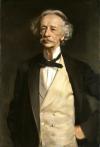
Coventry Kersey Dighton Patmore
Born in July 23, 1823 / Died in November 26, 1896 / United Kingdom / English
Biography
Victorian poet and critic Coventry Patmore was born into a literary household in Essex, England. His father, editor and novelist Peter George Patmore, educated his son, sent him to Paris when he was 16, and encouraged him to publish his first book, Poems (1844). Coventry Patmore’s subsequent collections of poetry include Tamerton Church Tower (1853) and The Angel in the House—composed of four volumes: The Betrothal (1854), The Espousals (1856), Faithful for Ever (1860), and The Victories of Love (1863).
Patmore worked at the British Museum from 1846 to 1865 and was associated with the Pre-Raphaelites. His acquaintances included William Holman Hunt, Dante Gabriel Rossetti, Alice Meynell, and John Ruskin, and his portrait was painted by John Singer Sargent. Patmore also wrote essays on art, including the collections Principles in Art (1889) and Religio Poetae (1893).
The Angel in the House presented a portrait of married life that became a Victorian ideal of domestic bliss. The work was inspired by Patmore’s first wife, Emily Augusta Andrews. Andrews was an author of children’s stories and the mother of six of Patmore’s children. They were married from 1847 until her death in 1860.
Patmore traveled to Rome and converted to Roman Catholicism in 1864. After Emily Patmore’s death, he was married to Marianne Caroline Byles from 1864 until her death in 1880. In 1865 he left the British Museum to manage his estate, Heron’s Ghyll, in Sussex. Patmore’s third wife was Harriet Robson, his children’s governess.





